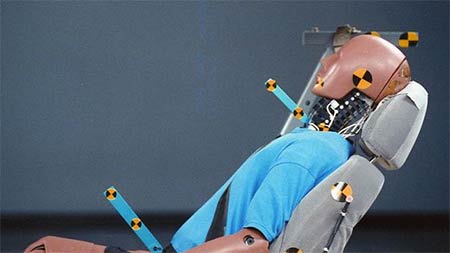Reducing Neck Injuries in Rear-End Crashes
By Matthew J. DeGaetano, DC and Adam Shafran, DC

New vehicle seat and head restraint designs are reducing neck injuries in rear-end crashes.
New research from the Insurance Institute for Highway Safety finds that some new designs of seats and head restraints are reducing neck injuries among car occupants involved in rear-end crashes. This is the first U.S. study to measure the effectiveness in real-world crashes of some of the innovative designs that manufacturers are beginning to introduce.
Nationwide, Progressive and State Farm insurance companies supplied claims data for the study and participated in the research.
For a long time, most of the head restraints in passenger vehicles weren’t high enough or close enough to the backs of many occupants’ heads to provide effective protection against neck injury in rear-end crashes. Recently, many automakers have been redesigning head restraints and seatbacks, in most cases by improving restraint geometry and in other cases by adding features intended to reduce neck injury risk dynamically during crashes.

The Institute studied three approaches used to redesign seats and head restraints:
- A straight forward approach is to improve the geometry of the restraints so they can be positioned behind and closer to the backs of most occupants’ heads. Among the manufacturers that have made this improvement is Ford. The geometry of the head restraints in 2000-02 Ford Taurus and Mercury Sable models is improved compared with earlier models of the same cars.
- Saab introduced active head restraints. As an occupant’s torso sinks back into the seat during a rear-end crash, a mechanism in the seatback pushes the head restraint up and toward the back of the head. In addition to Saabs, some General Motors and Nissan models are equipped with these restraints.
- Volvo and Toyota focused on seatbacks, designing them to yield in rear-end crashes to reduce the forward acceleration of occupants’ torsos. Volvo dubs its design a whiplash injury prevention system (WHIPS), which involves a specially designed hinge at the bottom of the seatback allowing it to move rearward to reduce the forward acceleration of the torso. This system includes head restraints with good geometry — that is, restraints that are high and close to the back of the head. Toyota’s seat design, which the automaker calls a whiplash injury lessening (WIL) system, allows an occupant’s body to sink farther into the seatback during a rear impact. The geometry of the head restraint is good in one of the two models studied with a WIL system and acceptable in the other.
The key to reducing whiplash injury risk in rear-end crashes is to keep an occupant’s head and torso moving together. The redesigned seats and head restraints are all intended to reduce the differential motion of the head and torso. The question addressed in the Institute’s new research is whether these redesigned seats and head restraints are doing a better job of reducing neck injuries in rear-end crashes, compared with the designs in older models of the same cars.
“There’s evidence that many of the new designs are working. In some cases, the reductions in insurance claims for neck injuries are dramatic,” says Institute chief operating officer Adrian Lund, who is an author of the research report.
Percent change in neck injury claim rates for new seat/head restraint designs compared with old designs.
The researchers identified 2,641 property damage liability claims for rear-end crashes of the cars included in the study — Taurus and Sable models with and without improved head restraint geometry, Volvo S70s with and without WHIPS, Toyota and Lexus models with and without the WIL system, plus a number of Buick, Nissan, Pontiac, and Saab models with and without active head restraints. The rates of insurance claims for driver neck injuries in rear-end crashes were compared before and after the seat and/or head restraint design changes. One definitive finding is a 43 percent reduction in neck injury claim rates for the Saab, General Motors, and Nissan models with active head restraints, compared with similar cars before such restraints were introduced.
“This is a huge improvement,” Lund points out. Before/after comparisons of Volvos and Fords also yielded impressive reductions in claim rates, but these results weren’t definitive because they weren’t statistically significant. Still, “the results are encouraging, especially when we look at the even larger effects for women,” Lund says.
In Toyotas with the WIL system, neck injury claim rates didn’t decrease. In fact, there was a slight increase, but there were too few Toyota data for this result to be statistically significant. “These results are disappointing,” Lund says, “but we’re working with Toyota to get a better understanding of the results and to see if better results might be expected with newer WIL designs.”
Where reductions in neck injury claims were found, they were greater for women than for men. Saab’s active head restraint design produced a 55 percent reduction in claim rates for women, compared with a 31 percent reduction for men. The effects of Ford’s improved head restraint geometry were a 37 percent claims reduction for women and an 8 percent increase (nonsignificant) for men. Volvo’s WHIPS was associated with a nonsignificant 69 percent reduction in neck injury claim rates for women, while the change for men was negligible.
Percent reduction in neck injury claim rates, by driver gender, new seat/head restraint designs compared with old.
Women’s neck injury rates were much higher to begin with. “Throughout whiplash injury research, the finding has been that women are at greater risk, so it’s good that the women seem to be enjoying more of the benefits of the improved designs,” Lund says.



